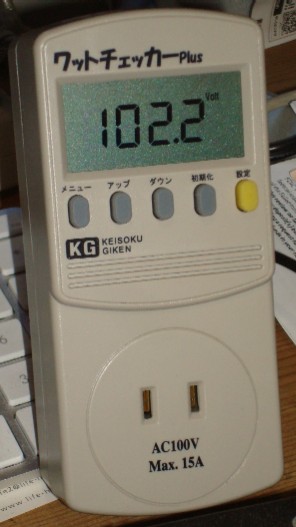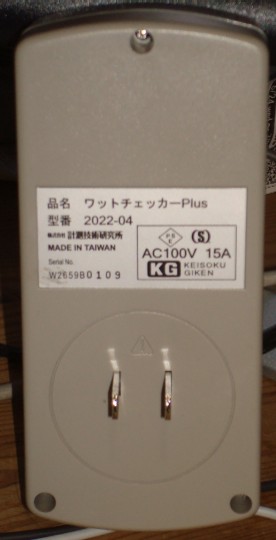This week it will be twenty years since I had the privilege to become an eyewitness to the Velvet Revolution (Czech: sametová revoluce) in then Czechoslovakia. With close friends of mine I attended a mass demonstration at Letna Park in Prague to mobilize for a general strike the following day, which ended 4 decades of Communist Party rule.
The following is an account of these events that I wrote about 10 years later, with photographs taken on that cold winter day.
[Start of original article]
Revolution in Prague
I have long had friends in Czechoslovakia, some 100 km (60 miles) east of where I was born. In 1968 a massive invasion of Soviet, East German and other Warsaw pact armies ended “socialism with a human face”, a daring but short-lived experiment by liberal communist prime minister Alexander Dubcek. My friend later showed me underground leaflets distributed then, that he had secretly stashed away. I was only seven years old when that happened, but I still remember being frightened after hearing my father and uncles talking about whether the invasion could mean WW3.
Nine years later, a group of intellectuals formed a human rights organization called “Charta 77”. Its leaders were playwright Vaclav Havel and Jiri Dienstbier. Another prominent member was Petr Uhl. The opposition group was persecuted and its members spent many years in Czech prisons.
Following “perestroika” in Russia under Mikhail Gorbachev, political change built up momentum across Eastern Europe. Poland voted for a non-communist government. Hungary took down the barbed wire along its border to Austria, triggering a mass exodus of East Germans to the west. Mass demonstrations in Leipzig, Dresden and other east German cities followed. Then thousands of East Germans invaded the West German embassy in Prague, forcing the East German government to let them emigrate. Soon after, the Berlin wall and border checkpoints to West Germany were opened and millions of East Germans could travel west for the first time in four decades.
Infected by the bold spirit of their neighbours, Czech students publicly demonstrated near Vaclav square in the center of Prague, commemorating Czech students who had dared to demonstrate against Nazi occupation 50 years earlier. Despite the non-confrontational theme, police violently broke up the demonstration, brutally beating the students. Photos of the events emerged and public outrage followed. The national television eventually had to show pictures of the clubbing. This triggered growing mass demonstrations on Vaclav Square in central Prague, which got so big that they had to be moved to Letna Park, the usual site of the annual Mayday parade of the Communist Party (KSC). Two big rallies were to be held on Letna Park over the weekend, to spread the call for a general strike, to demonstrate to the Communist Party that it was isolated and that the people wanted it to resign.
When I saw the reports on the TV news, I decided to leave for the Czech border the very next morning. East of the Bohemian Forest the snow was about 30 cm (1 ft) deep. Bohemia was covered in white and the infamous “Bohemian Wind” was blowing. I experienced no particular problems at the border and found relatively little traffic on the wintery roads. My 4wd Audi took me to Teplice, in northern Bohemia, some 60 km (40 mls) south of Dresden, without any problems due to ice or snowdrifts.

My friends were surprised to see me, of course. Throughout the afternoon we watched television. All regular programming had been canceled and there were only interviews, live reports and speeches. All censorship had been dropped. Journalists reported about anything, said anything, gave a forum to anybody. I was probably watching the most free television in all of Europa at that moment. Finally it was announced that Vaclav Havel would speak. I was utterly amazed. The man who had all his plays banned, had been jailed, made to earn his living shoveling coal, probably the most stubborn oppositional in this country could speak freely to his compatriots. And speak he did, I don’t remember if it was for 30 minutes or an hour. The camera was his, and the audience too. That same afternoon there were a million people on Letna park, at a demonstration of the Obcanske Forum (civic forum, the largest organization within which was Charta 77).
I talked to my friend about going to Prague on Sunday together. His wife was worried what might happen. What if they had their pictures taken, got arrested and lost their jobs? But a million people had demonstrated already and Havel had been on TV. The Berlin Wall had been broken too. This was not Prague 1968 any more. This time it would work. Well, if he was going then so was she.
The roads were icy as we headed down to Prague the next day, but it was a pleasure to drive in the Audi. Letna Square is on one of the hills high above the centre of Prague, which makes it cold and windswept in the winter. We parked in the suburbs within walking distance and followed the crowds.
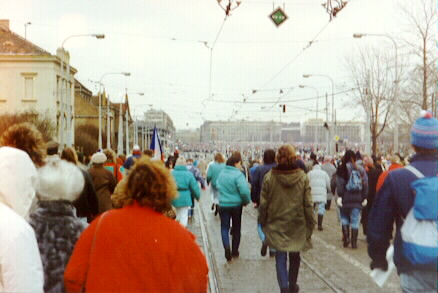
The first thing that surprised us was that there was no police. Usually, they were all over the place. Now, not one. I was going to witness an event with anywhere upwards of 500,000 people and would not see a single policeman all afternoon, in what until days ago could only have been described as a police state. Instead we saw students with white armbands, or civic forum badges, who took care of everything. The government must have decided that violence was too risky.
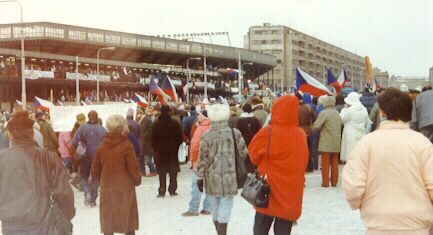
This ice-hockey stadium at the edge of the square was used by the speakers, amongst them Havel, Dienstbier and Petr Uhl, who had just been released from jail were he had been taken for spreading the (luckily mistaken) rumour that a student had been killed during the demonstration the previous weekend.
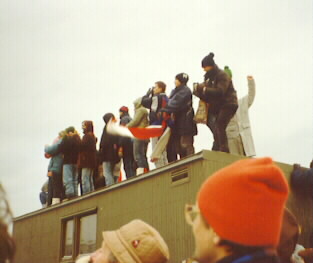
The crowd was so huge, it was difficult to see how big its was from anywhere in the middle. So I passed up my camera to one of these guys and they were kind enough to take some pictures in various directions. No one was paranoid about having their pictures taken any more. People had shaken off fear.

This is the view towards the stage. Many people were wearing ski hats or jackets in the colours of the Czechoslovakian flag. This was not just an anti-communist or anti-Stalinist event, since it had been a foreign invasion that suppressed freedom 21 years earlier. This was very much a nationalist event too. The revolution of 1989 was as much about reclaiming national sovereignty lost in 1968 as it was about restoring democracy lost in 1948.
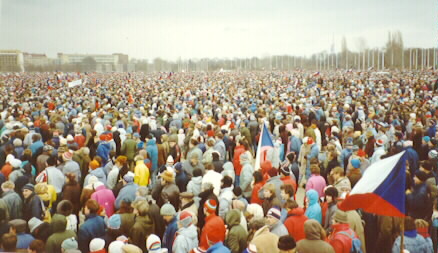
That’s the view towards the right hand side of the square. I was told Letna park can hold one million people. It had been full on Saturday. Looks pretty full to me on that Sunday too!
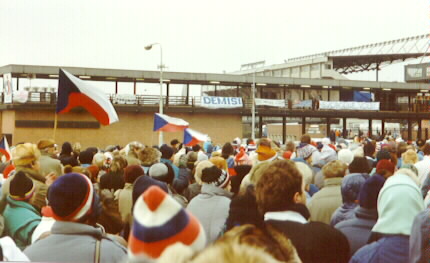
The slogans on three of the banners read: “Step down!”, “Civic Forum” and “Free Elections!”
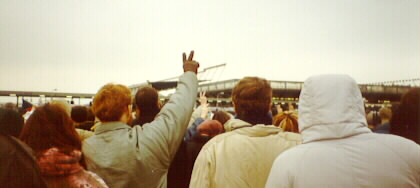
The Victory sign became popular over night, as a sign of confidence in the effectiveness of the general strike the following Monday.
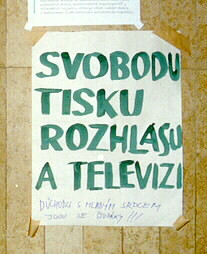
“Free newspapers, radio and television” (my Czech is pretty rudimentary…) — a message against censorship

On the left (in red): “End one party elections!” Below: Valtr Komarek was a renowned economist who came out against the government.

Two of the young people who organized security, directing traffic and handing out information. Yes, it was cold and windy too.
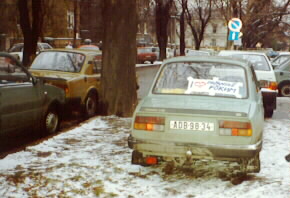
A Skoda car (Prague license plate) with “I love civic forum” in the rear window.
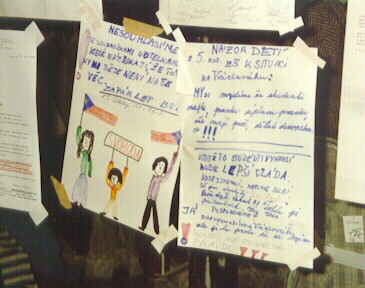
A revolutionary family effort. The child in the middle holds a banner with “Svoboda” (Freedom) written on it
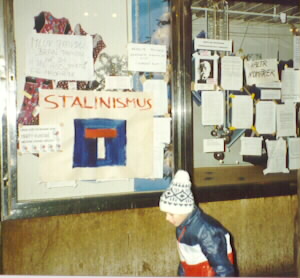
Stalinism hit its dead end. All shop windows were plastered with political messages, as were the underground (subway) stations that are the arteries of public transport in Prague.
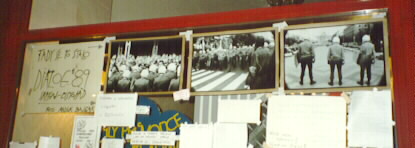
Photographs of the violently crushed students demonstration that caused the outrage triggering the mass demonstrations.
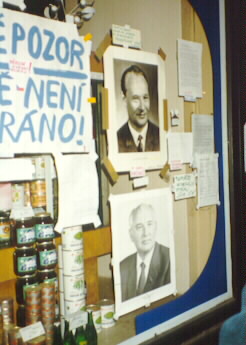
Pictures of Alexander Dubcek, father of the “Prague Spring” of 1968 and of Mikhail Gorbachov whose hands-off policy discouraged the Czech communists from resorting to violence in the way the Chinese leadership had done at Tien-An-Men square earlier that year.
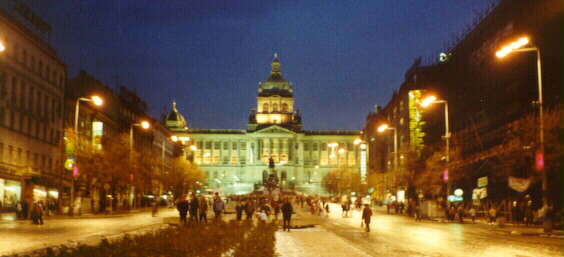
View towards the top end of Vaclav Square, with the National Army Museum in the back. In front of the museum is the Vaclav Monument, which most of us remember from pictures showing it surrounded by Russian tanks in August 1968.

A field of candles lit for the victims of the government.

Cheerful pedestrians were waving the V-sign at passing motorists who honked their horns in solidarity.
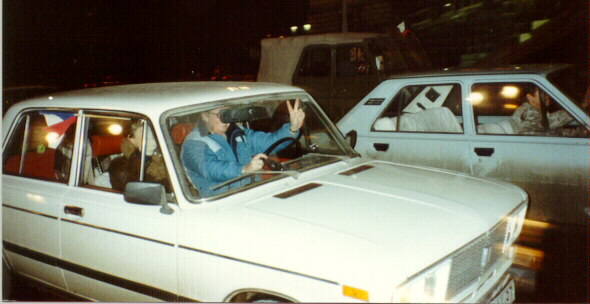
V-signs and flags every where — as along the street between Vaclav Monument and the museum.
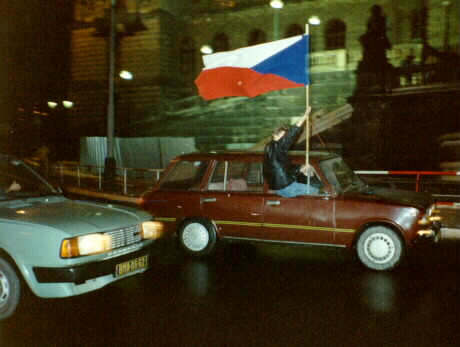
People had been waiting for this day for at least 21 years. Until a few years aerlier the National Army Museum in the background still bore the bullet holes were it had been hit by Soviet tank artillery.

Ladas, Skodas, Trabants and Wartburgs in a freedom parade.
The following day was scheduled to be a general strike. The opposition groups were headed by well known intellectuals. The big demonstrations had all been in Prague. People still were not sure what the outcome would be in the smaller towns, away from the capital and how effective the strike call would be amongst industrial workers, such as the Skoda factories.
The right to go on strike
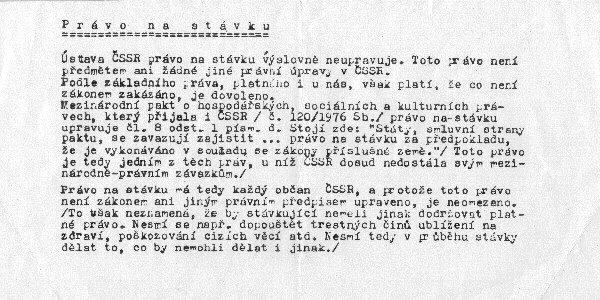
The right to go on strike
(See here for an English Translation of this flyer)
But Czechs have long held intellectuals in high respect, like to read and to watch plays. Famous actors, whole theaters and even national football (soccer) players publicly came out in support of the strike call. By Monday afternoon, when I was back in Germany, the figures were in: The strike was a great success, the government had lost every pretense of being in control and there was nothing else left but to withdraw in an as orderly way as possible. Within days, a transitional cabinet was established and former oppositionals took control of public institutions. An election later confirmed that communist majority had always been a carefully constructed fiction.
Vaclav Havel (president of the Czech Republic until February 2003) is one of the politicians who I respect most, for his courage, his non-violent struggle, his sense of humour and his humane values.
[End of original article]
Twenty years later
I went back to the Czech Republic about ten years later, with my wife and kids. We visited Prague as tourists. I was amazed how much everything had changed. I heard English spoken everywhere, where before most tourists were from East Germany or other parts of the Eastern Block. Prague had become a magnet for young people from all over the world.
Things have not been easy for people, as not all have materially benefited equally from the changes. The old planned economy suffered from low productivity and horrendous ecological problems (especially acid rain in the lignite mining areas in Northern Bohemia), but everybody had been guaranteed a job of some sort. Hopes had been so high after 40 years of repression and mismanagement that people were bound to be disappointed by reality (just as Americans were bound to be somewhat disappointed after voting for change in the 2008 US Presidential Election, I might add).
Rule by a repressive one party bureaucracy was a dead end for Czechoslovakia. Now the Czech Republic is a free country again. Its citizens need not fear being arrested or losing their jobs or be denied education for speaking their minds. They are free to travel and to trade and to seek opportunities.
The events of twenty years ago gave me hope in the human spirit. They showed me what people can achieve when they dare to dream, to follow their moral convictions and to reach out to their fellow human beings instead of being bowed by fear.
























